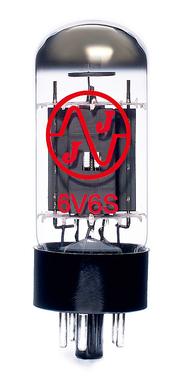JJ Electronics 6V6 Vacuum Tubes
![]()
![]()

My Fender Champ X2 guitar amplifier remains among my favorite boxes of technology. Brilliantly conceived, flawlessly executed and cool enough to shatter penguins, it rocks to a degree that would be best measured on the Richter scale. Whoever thought of combining a leading-edge digital effects processor with classic vacuum-tube power output should have been given a corner office and the best parking space in the company lot.
The Champ X2 I bought shipped with Groove Tubes. Guitarists who spend sixteen or more hours a day posting to equipment forums are wont to say unkind things about these devices, but in the real world, they’re not bad tubes. To their credit, they’re substantially better than the tubes manufactured back in the twentieth century, and my Fender Champ played them well.
When the factory tubes in my amp started to show their age… or rather, to sound their age… I came to appreciate that vacuum tubes can be chosen for their sound qualities every bit as much as would be the instruments played through them. Most of the tubes manufactured in eastern Europe sound excellent – not all of them sound alike.
JJ Electronics hails from the Slovak Republic, where it was founded in 1993. It appears to do nothing but manufacture tubes, tube-related passive electronic components and some glorious high-end vacuum tube amplifiers. I settled on a pair of JJ Electronic 6V6S output tubes and one of their ECC83 S twin triode preamplifier tubes – a 12AX7 in disguise.
While my Fender Champ X2 had sounded acceptable with its original Groove Tube glass, it was transformed by the JJ Electronics devices. Tube sound is highly subjective, but these things play superbly. The bottom end is flawlessly clean, but also dark and resonant. High notes sound bright and textured without any sense of the brittle, nasal quality of some tube outputs.
What’s still more remarkable abut the JJ tubes is how quiet they are when they’re not playing. Despite there being a torrent of electrons smashing into metal anodes in each one, these tubes are dead silent. Even with the volume cranked up to truly seismic levels, my Champ produced no detectable hiss.
A further quality of the new tubes was that they seem to remain stable after they’ve warmed up and become comfortable. Their tonal qualities don’t change appreciably, even after extensive playing.
Considering how unrepentantly funky vacuum tubes were back in the twentieth century, it’s remarkable how refined they’ve become.
One of the subtle refinements of the JJ Electronics tubes I received was that while they were made in eastern Europe, they arrived at our digs after a protracted journey through Arizona. They were affixed with stickers that identified them as having been matched by Apex Tube Matching, a company that does pretty much what their name says. When you buy a pair of these tubes, they’ll have been selected to have identical electronic characteristics.
Matched output tubes are a fundamental element of great tube sound. The output stage of a class AB tube amplifier uses one tube to amplify the positive half of whatever’s being played through it, and a second tube to amplify the negative half. If the two tubes don’t behave identically, the sound they’re playing will be distorted.
Apex Tube Matching marks the tubes it matches with the plate current and transconductance values for each device. Don’t be concerned if the foregoing sentence sounded like Martianspeak. If you buy a matched pair of JJ Electronics output tubes, you can confirm that they were meant to play together by checking that the numbers for both tubes are identical.
Overdrive
A new set of tubes has substantially enhanced my favorite amplifier, and even after considerable digging, research and profanity, I’ve yet to encounter other tubes that play half as well as these guys. They make the prospect of unplugging whichever guitar I’ve chosen and returning it to its case almost painful.
That it’s possible to buy vacuum tubes half a century after they were supplanted by solid state devices is a bit surprising. That they’ve actually been improved upon to this degree is a source of awe and wonder.
… and we live in the middle of a big forest where all our immediate neighbors are bears, so turning them up to ten is always an option. The universe really is a great place to live.